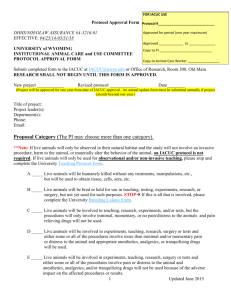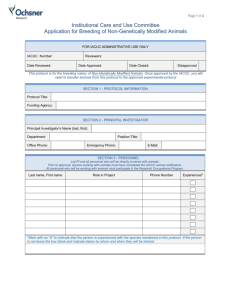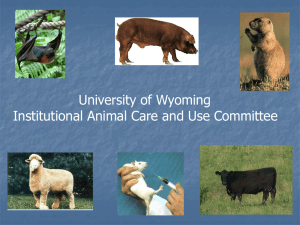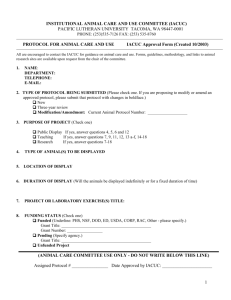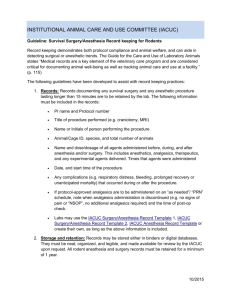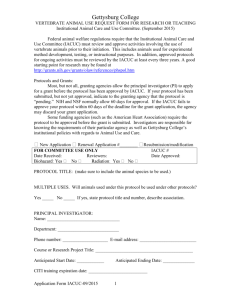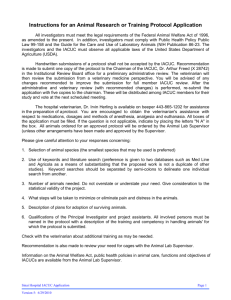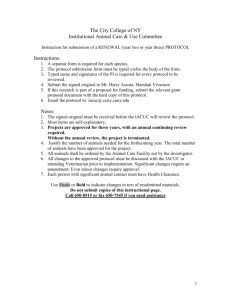FOR IACUC USE Protocol # Approved for period (one year
advertisement
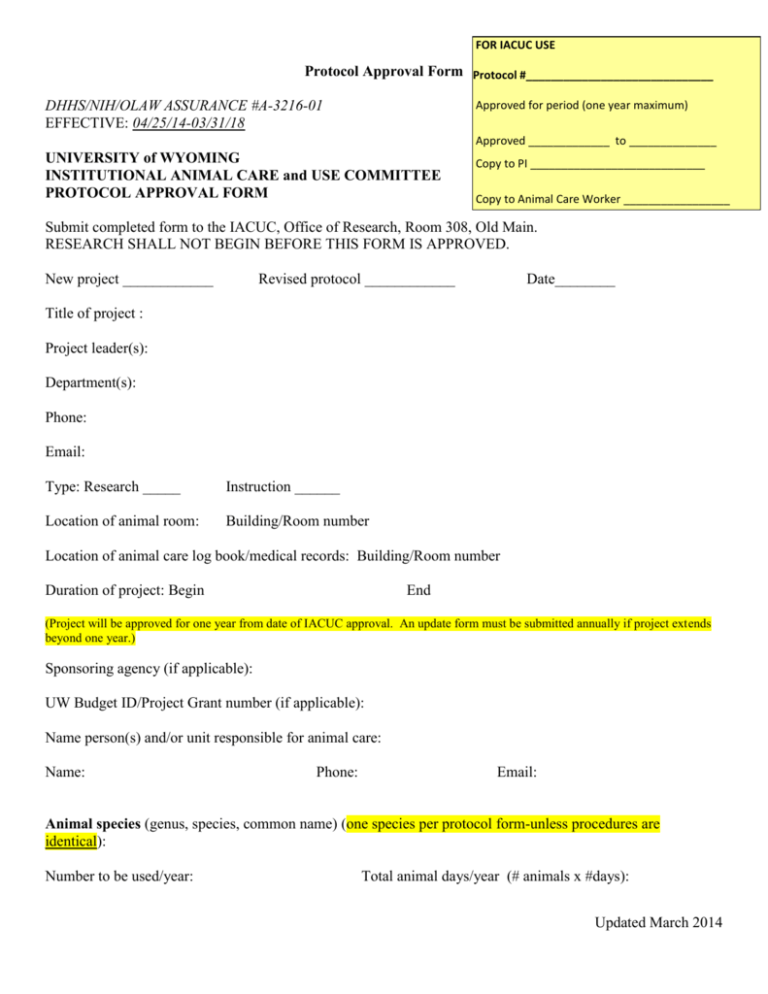
FOR IACUC USE Protocol Approval Form Protocol #______________________________ Approved for period (one year maximum) DHHS/NIH/OLAW ASSURANCE #A-3216-01 EFFECTIVE: 04/25/14-03/31/18 Approved _____________ to ______________ UNIVERSITY of WYOMING INSTITUTIONAL ANIMAL CARE and USE COMMITTEE PROTOCOL APPROVAL FORM Copy to PI ____________________________ Copy to Animal Care Worker _________________ Submit completed form to the IACUC, Office of Research, Room 308, Old Main. RESEARCH SHALL NOT BEGIN BEFORE THIS FORM IS APPROVED. New project ____________ Revised protocol ____________ Date________ Title of project : Project leader(s): Department(s): Phone: Email: Type: Research _____ Instruction ______ Location of animal room: Building/Room number Location of animal care log book/medical records: Building/Room number Duration of project: Begin End (Project will be approved for one year from date of IACUC approval. An update form must be submitted annually if project extends beyond one year.) Sponsoring agency (if applicable): UW Budget ID/Project Grant number (if applicable): Name person(s) and/or unit responsible for animal care: Name: Phone: Email: Animal species (genus, species, common name) (one species per protocol form-unless procedures are identical): Number to be used/year: Total animal days/year (# animals x #days): Updated March 2014 Number to be used/project: Total animal days/project: Source of animals: Proposal category: A _____ Live animals will be humanely killed without any treatments, manipulations, etc., but will be used to obtain tissue, cells, sera, etc. B _____Live animals will have manipulations, surgery, etc. performed while anesthetized. The animals will be humanely killed at termination of the experiment without regaining consciousness (non-survival surgery). C _____ Live animals will receive a painful stimulus of short duration without anesthesia behavior experiments with flight or avoidance reactions) resulting in a short-term traumatic response. Other examples in this category are blood sampling, injections of adjuvant, etc. D _____ Live animals will have significant manipulations, surgery, etc., performed while anesthetized and will be allowed to recover (survival surgery). Such procedures (e.g., chronic catheters, surgical wounds, implants) cause a minimum of pain and/or distress. Also included are mild toxic drugs or chemicals, tumor implants (including hybridomas), tethered animals, shortterm restrained animals. E _____ Live animals will have significant manipulations, surgery, severe discomfort, etc. without benefit of anesthesia, analgesics or tranquilizers. Examples are toxicity testing, radiation sickness, irritants, burns, trauma, biologic toxins, virulence challenge, prolonged restriction of food or water intake, cold exposure, restraint, or drug addiction. All use of paralytic agents (curare-like drugs) must be included in this category. O _____ Other: Standard husbandry practices, weighing, observation, insemination. 1) a. Purpose (in lay terms) b. Scientific objective(s) c. Potential for use of in vitro systems or computerized models instead of live animals i. Elaborate on current availability of animal data that could be used to predict outcomes ii. Elaborate on the uniqueness of the study such that the requirement for live animal research is necessary 2) Describe all procedures: Description should allow the IACUC to understand the experimental course of an animal from its entry into the experiment to the endpoint of the study. a. Overview of procedures (Reference citations for b-e) b. Type and duration of restraint c. Name and dose of anesthesia and/or tranquilizer (contact attending veterinarian) d. Surgical procedures Updated March 2014 i. pre-operative procedures ii. aseptic methods to be used: surgical attire iii. who will perform surgical procedures iv. where will surgical procedures be performed v. non-survival/survival surgery vi. justification if more than one surgical procedure per animal d. Post-surgical care i. Recovery facility ii. Name, dose, route of administration and regimen for analgesia; (investigate literature for pain management for species used; consult attending veterinarian) 3) Justification for species chosen (lowest possible species on phylogenetic scale) 4) Statistical justification for the specified number of animals (assistance to determine the appropriate number of animals per treatment) a. Justification for number of animals per experiment b. Justification for number of experiments per year (as stated on page 2) c. Literature cited/reviewed for justification of number of animals proposed 5) Will animals be subjected to euthanasia? a. Method of euthanasia b. Drug and dosage c. If using drugs for euthanasia, describe disposal of animal remains. d. If animals will not be euthanized, describe plan for future use or other dispersal. 6) If the proposal category checked is D or E, then the experimental procedures may cause more than momentary or slight pain or distress. Address the following: a. Provide written narrative description, including methods and sources used in search, of how it was determined that alternatives to potentially painful or distressful procedures are not available. Please Note: The purpose of this search is NOT to explain why the research does not duplicate Updated March 2014 other work. The purpose of this search is to show that there are no alternative to the potentially painful or distressful procedures outlined in this protocol. Including i: Literature cited; database references must include name of databases searched, the date of the search, period covered, and keywords used. For assistance with literature searches please see: http://libguides.uwyo.edu/AWA or contact the following University of Wyoming Librarians: Jenny Garcia at: jgarcia@uwyo.edu or David Kruger at: tseliot@uwyo.edu . And/Or ii: personal communications Please refer to Animal Welfare Act 9CFR Section 2.31 (d) (1) (ii) b. A minimum of two databases must be searched. i. Database 1: ii. Database 2: iii. Please add additional databases as necessary 7) Explain why this research does not involve unnecessary duplication of previous research or experiments Describe the literature search method. For assistance with literature searches please see: http://libguides.uwyo.edu/AWA or contact the following University of Wyoming Librarians: Jenny Garcia at: jgarcia@uwyo.edu or David Kruger at: tseliot@uwyo.edu . a. Please indicate date of search, name of databases, keywords used, and number of responses. A minimum of two databases must be searched. i. Database 1: ii. Database 2: iii. Please add additional databases as necessary b. Discuss relevant literature to justify why unnecessary duplication of previous research is not involved. Please refer to Animal Welfare Act 9CFR Section 2.31 (d) (1) (iii) 8) Training/experience documentation: Federal regulations require appropriate training and experience for all personnel involved in the care and use of animals. An up-to-date "Verification of Training for Animal Work" form must be on file in the Research Office for each person, including the P.I., involved in the care and use of animals to be used in this protocol. Verification of Training for Animal Work form: http://www.uwyo.edu/Research/forms.htm For PI(s) (name): For animal care worker/lab technician (name): Graduate student(s) (name): Others (name): attached ___ on file ___ date _____________ attached ___ on file ___ date _____________ attached ___ on file ___ date _____________ attached ___ on file ___ date _____________ Updated March 2014 Please list specific experience and/or qualifications of each animal care worker necessary to perform the specific techniques and procedures described in this protocol (such as surgery) if not included on the "Verification of Training for Animal Work" form attached or on file. Principal Investigator Assurance: "I have received a copy of the NIH Guide for the Care and Use of Laboratory Animals and/or The Guide for the Care and Use of Agricultural Animals in Agricultural Research and Teaching and will provide for the care, use and treatment of the animals used for the purpose described above accordingly. I will use procedures which will avoid or minimize discomfort, distress and pain to animals used in my research. I have considered alternatives to procedures that may cause more than momentary slight pain or distress to the animals. These studies do not unnecessarily duplicate previous experiments. I HAVE CONSULTED AS NEEDED WITH ATTENDING VETERINARIAN (David Evertson 745-7341), OR BACKUP VETERINARIAN ON STAFF AT ALPINE VETERINARY CLINIC,DURING THE PLANNING OF THIS PROJECT AND WILL CONSULT WITH THE VETERINARIAN DURING THE PROJECT. I will inform the attending Veterinarian immediately if any problems occur, including unanticipated pain or distress, injury, morbidity or mortality. I will submit a revised protocol for IACUC approval if any significant deviation from the approved project procedures occurs. I will submit an annual update for IACUC approval for continuation if this project extends beyond one year. I assure the IACUC that all persons involved in the care and use of animals used to conduct this protocol have received the appropriate training and are qualified to perform the procedures described above." __________________________________ Principal Investigator .……………….Date REVIEWED AND APPROVED: __________________________________ Department Chairperson ……………Date _________________________________ Veterinary Officer ………………… Date ACTION BY THE ANIMAL CARE AND USE COMMITTEE: APPROVED _____________________________________ Chairperson, IACUC Date DISAPPROVED ________________________________________ Associate Vice President for Research Date Updated March 2014
